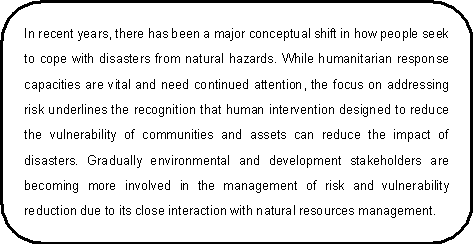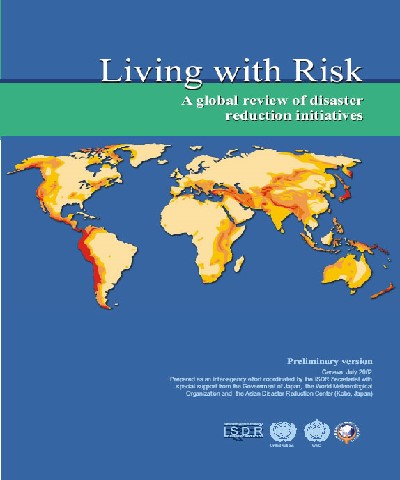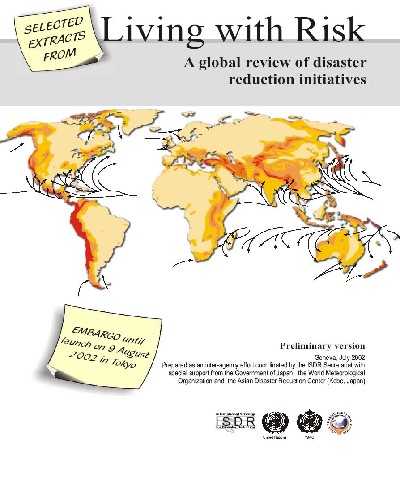TOP PAGE > Publications/LWR
Introduction
This is a preliminary version of Living with Risk - a global review of disaster reduction circulated for consultation. It includes a
compilation of initiatives and reference information. It focuses on disaster
risk reduction as envisioned in the International Strategy for Disaster
Reduction. Therefore, it does not discuss specific experiences of disaster
preparedness, response or recovery. It is intended for practitioners in disaster
management, environmental and sustainable development, to provide guidance,
policy orientation and inspiration. It is a first effort to collect and
systematise information on disaster risk reduction initiatives, by illustrating
the full range of activities and some of the many actors involved. While it is
still limited geographically, it has the goal to reach common understanding of
the issues.

The review is based on examples of activities and various applications, identifying trends where possible. It starts with the important contexts of sustainable development surrounding disaster risk reduction followed by a chapter on risk trends and assessment. Sections then describe some of the different elements of disaster risk reduction illustrated from global, regional and national examples. Policy and institutional frameworks; knowledge and information management; and the application of specific measures, such as environmental management, land use planning, engineering protection of critical facilities, financial tools and early warning systems are highlighted elements. A section on relevant international agendas and the role of the different parts of the United Nations involved with disaster risk reduction provides for fuller understanding of the links between them. Finally, the report outlines some of the challenges for the future by suggesting the need for setting specific targets and monitoring progress. The report provides users with reference material and a directory of many international, national and educational organizations dedicated to risk reduction.
Some development organizations have published reports and adopted policies to address disaster risk in the context of development. These are valuable tools and help increase public and political interest in risk reduction and the objectives of ISDR. For example, in 2001, UNDP prepared a vulnerability risk index for least developed countries and is currently preparing a World Vulnerability Report, which focuses on the links between development and disasters. UNEP has released the Global Environmental Outlook, GEO3, in 2002 prior to the World Summit for Sustainable Development, which includes a thorough analysis of environmental change and vulnerability with a special section on disasters. In its reports for 2001 and 2002, the World Bank analysed the relations between environment, poverty and natural disasters. The International Federation of Red Cross and Red Crescent Societies publishes its World Disasters Report annually. This year 2002, the focus is on reducing risk.
Yet, a comprehensive and systematic review of ongoing initiatives is still lacking. The elaboration of a comprehensive framework to measure disaster risk reduction efforts over time, which could set the ground for developing specific risk reduction targets and thereby contribute to enhancing capacities in governments and communities is also needed. This review is a step in that direction, inviting consultation and partnership.

The review is based on examples of activities and various applications, identifying trends where possible. It starts with the important contexts of sustainable development surrounding disaster risk reduction followed by a chapter on risk trends and assessment. Sections then describe some of the different elements of disaster risk reduction illustrated from global, regional and national examples. Policy and institutional frameworks; knowledge and information management; and the application of specific measures, such as environmental management, land use planning, engineering protection of critical facilities, financial tools and early warning systems are highlighted elements. A section on relevant international agendas and the role of the different parts of the United Nations involved with disaster risk reduction provides for fuller understanding of the links between them. Finally, the report outlines some of the challenges for the future by suggesting the need for setting specific targets and monitoring progress. The report provides users with reference material and a directory of many international, national and educational organizations dedicated to risk reduction.
Some development organizations have published reports and adopted policies to address disaster risk in the context of development. These are valuable tools and help increase public and political interest in risk reduction and the objectives of ISDR. For example, in 2001, UNDP prepared a vulnerability risk index for least developed countries and is currently preparing a World Vulnerability Report, which focuses on the links between development and disasters. UNEP has released the Global Environmental Outlook, GEO3, in 2002 prior to the World Summit for Sustainable Development, which includes a thorough analysis of environmental change and vulnerability with a special section on disasters. In its reports for 2001 and 2002, the World Bank analysed the relations between environment, poverty and natural disasters. The International Federation of Red Cross and Red Crescent Societies publishes its World Disasters Report annually. This year 2002, the focus is on reducing risk.
Yet, a comprehensive and systematic review of ongoing initiatives is still lacking. The elaboration of a comprehensive framework to measure disaster risk reduction efforts over time, which could set the ground for developing specific risk reduction targets and thereby contribute to enhancing capacities in governments and communities is also needed. This review is a step in that direction, inviting consultation and partnership.
United Nations Press Release (IHA/02/8, 5 August 2002)
(pdf)
| UN UNVEILS A ROADMAP TO A SAFER WORLD BY REDUCING RISK |



